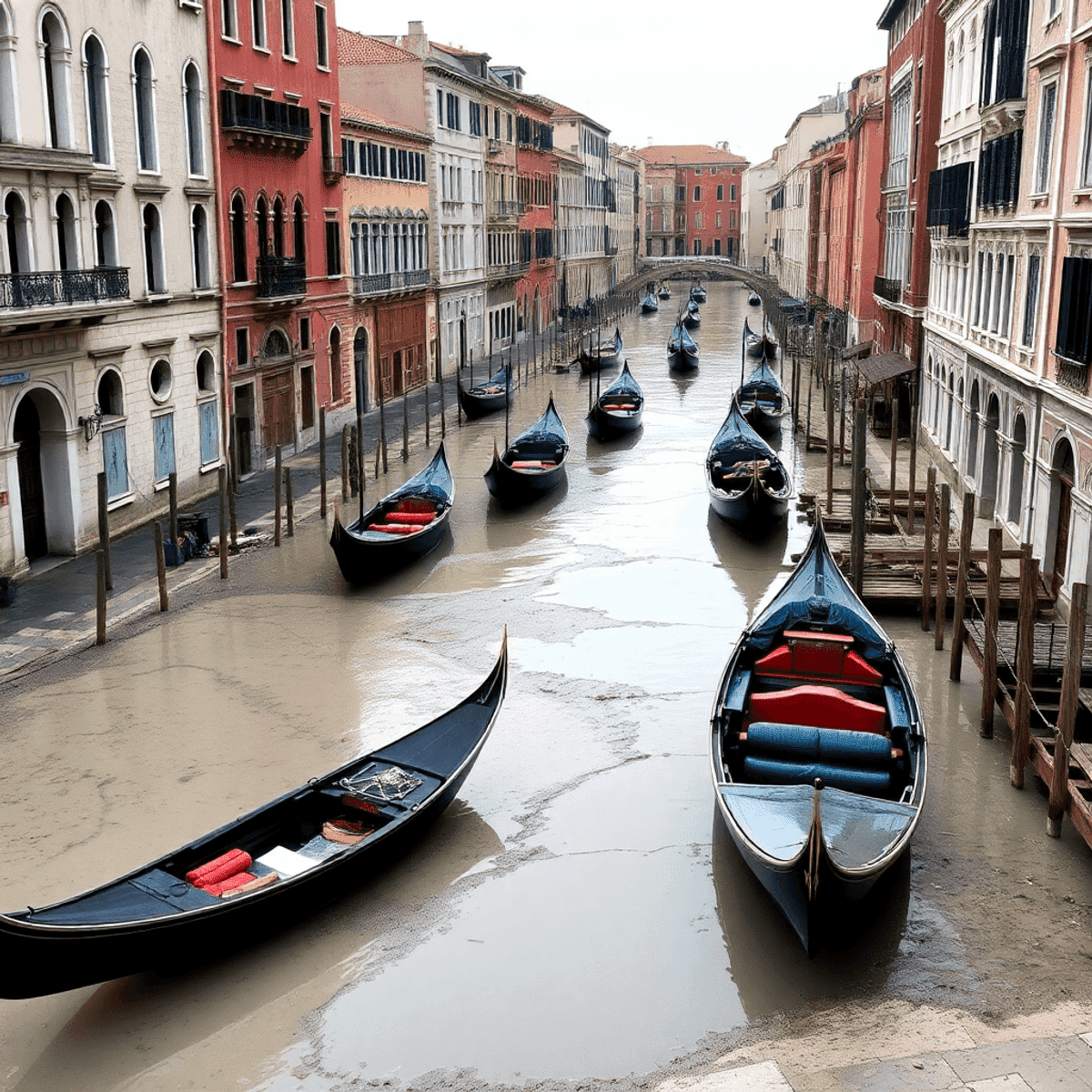Introduction
Venice, a city famous for its iconic canals, is a treasure trove of culture and history. These waterways are not only vital to the city’s charm but also play a crucial role in its economy, attracting millions of tourists each year. The gondolas gliding through the canals symbolize Venice’s unique lifestyle, where water serves as both transportation and a lifeline for local businesses.
Currently, Venice faces a pressing issue: the canals are at risk of getting dry due to low tides. This phenomenon, locally known as bassa marea, has left many canals partially dry, exposing mud and affecting navigation. Reports indicate that water levels have dropped approximately 70 centimeters (28 inches) below average in some areas.
In this article, you will learn about:
- The implications of low tides on Venice’s waterways
- The causes behind decreasing water levels
- The potential long-term risks to the city’s structural integrity and cultural heritage
- Local responses and innovative solutions aimed at safeguarding Venice’s future
Understanding these factors is crucial for anyone invested in preserving this UNESCO World Heritage site.
Understanding the Phenomenon of Low Tides in Venice
Low tides, known locally as bassa marea, represent a significant challenge for Venice, affecting both its waterways and the daily lives of its residents. These periods of reduced water levels can leave many of the city’s iconic canals partially dry, exposing muddy riverbeds and disrupting the intricate balance that sustains Venice’s unique ecosystem.
The Current State of Affairs
Recent measurements reveal alarming statistics: water levels in some areas are approximately 70 centimeters (28 inches) below average. This decline has serious implications for navigation, tourism, and the overall health of Venice’s canals. Gondolas and water taxis struggle to navigate through these shallow waters, impacting not only transportation but also the vibrant tourism sector that heavily relies on these waterways.
Historical Context
Historically, low tide occurrences have been part of Venice’s natural cycle. However, the frequency and extremity of these events have increased significantly in recent years.
Key points regarding this historical context include:
- Low tides typically manifest during winter months, yet current conditions have raised concerns among scientists and locals alike.
- The interplay between climate change and local weather patterns has intensified low-water events.
- Historical data indicates that while bassa marea is not new to Venice, it is becoming more pronounced due to environmental shifts.
The Contributing Factors
The combination of prolonged high-pressure systems over Western Europe and reduced rainfall across Italy has exacerbated these conditions. This perfect storm leads to a precarious situation for Venice’s waterways, where low tides threaten both daily life and cultural heritage.
The Need for Understanding
Understanding this phenomenon requires recognizing its complexity. The intricate relationship between climate change, historical trends, and current events highlights an urgent need for awareness and action to protect this UNESCO World Heritage site from further degradation.
Causes Behind the Decreasing Water Levels in Venice’s Canals
The Role of Climate Change in Venice’s Low Tide Crisis
Climate change is significantly impacting the water levels in Venice’s iconic canals. This phenomenon manifests in two contrasting yet related events: extreme flooding (known as acqua alta) and unusually low-water conditions (bassa marea). Both scenarios create a precarious balance for the city, threatening its infrastructure and cultural heritage.
Key factors contributing to this crisis include:
- High-Pressure Systems: A prolonged high-pressure weather system over Western Europe has led to reduced rainfall across Italy. This decrease in precipitation directly affects the water supply that feeds into Venice’s canals.
- Changes in Snowpack: The Alps, vital for Italy’s freshwater resources, have experienced less than 50% of their normal snowfall in recent years. As snowmelt diminishes, rivers like the Po are left struggling with water shortages, impacting water levels in Venice.
- Climate Change Impact: Climate change exacerbates both acqua alta and bassa marea events. Rising sea levels contribute to more frequent flooding during high tides, while shifts in weather patterns lead to extended periods of low tide. This creates a dual threat where the canals are at risk of drying out during low-water events.
The consequences extend beyond mere aesthetics or inconvenience; they pose serious environmental concerns. Navigating through shallow waters becomes increasingly challenging for gondolas and water taxis, essential for both daily life and tourism within the city.
Understanding these interrelated factors is crucial for grasping the urgency behind Venice’s current crisis. Without addressing climate change and its effects on weather patterns, the future of Venice’s canals appears bleak. The ongoing struggle against changing environmental conditions highlights the need for immediate action to protect this UNESCO World Heritage site from further degradation.
How Reduced Snowfall and River Health Affect Venice’s Canals
To understand why Venice is facing a low tide crisis, it’s important to look at the connection between decreased snowfall in the Alps and the declining water supply for rivers like the Po River. Several factors contribute to this situation:
1. High-Pressure System
A prolonged high-pressure weather system over Western Europe has resulted in reduced rainfall across Italy. This phenomenon has led to significant drought conditions affecting various regions, including Venice.
2. Alps Snowfall Decline
Recent years have seen less than 50% of normal snowfall in the Alps. As a vital source of water, this decline directly impacts river flows, which feed into Venice’s canals.
3. Po River Levels
Current reports indicate that water levels in the Po River are approximately 61% lower than usual. This alarming decrease severely limits the freshwater supply reaching Venice and contributes to alarming low tide conditions.
Environmental concerns regarding climate change further complicate these issues, driving both extreme flooding (acqua alta) and unusually low-water events (bassa marea). With Venice’s canals at risk of getting dry due to low tides, understanding these interconnected patterns becomes essential for future solutions.
Consequences of Low Water Levels on Navigation, Tourism, and Infrastructure
Low water levels in Venice’s canals present significant challenges for both navigation and tourism. The iconic gondolas and water taxis struggle to operate efficiently during periods of low tide. With water levels dropping dramatically, these vessels often find themselves navigating through shallow or partially dry canals, which can lead to:
1. Increased Risk of Damage
Gondolas and water taxis are designed for specific water depths. Insufficient water can result in scraping the canal bed, causing wear and tear on these traditional boats.
2. Extended Travel Times
Navigating through shallow waters requires caution, slowing down operations and affecting schedules.
Tourism faces its own set of impacts due to low-water conditions. Many visitors flock to Venice primarily to experience its famous waterways. As canals become more mud than water, the allure diminishes. Consequently:
1. Declining Tourist Numbers
Reports show that reduced navigability leads to fewer tourists willing to visit or engage in canal activities.
2. Economic Repercussions
Tourism is a backbone of Venice’s economy. A drop in visitor numbers threatens local businesses reliant on tourism, from gondola operators to restaurants and shops.
Addressing these challenges is crucial for preserving both the cultural charm of Venice and its economic stability as low tides continue to threaten the city’s vibrant identity.
Long-term Risks Posed by Low Tides to Venice’s Structural Integrity and Cultural Heritage Sites
The issue of low tides presents significant structural integrity risks from low water levels for Venice’s iconic buildings. When canals experience repeated dry conditions, several long-term consequences arise:
- Foundation Erosion: Buildings along the canals depend on stable water levels to maintain their foundations. Prolonged exposure to dry conditions can lead to erosion, compromising structural stability.
- Material Degradation: Many structures are built with materials susceptible to damage from fluctuating moisture levels. Dry air can cause bricks and mortar to crack, leading to costly repairs.
Cultural heritage sites stand at the forefront of this crisis. Notable examples include:
- St. Mark’s Basilica: This architectural masterpiece relies on consistent water levels for its preservation. Fluctuating conditions threaten the structural health of its intricate mosaics and foundation.
- Palazzo Ducale (Doge’s Palace): As an emblem of Venetian history, this site requires stable environmental conditions. The risk posed by low tides jeopardizes not only the building but also the cultural narratives it embodies.
Preserving these significant sites demands urgent attention as Venice’s canals are at risk of getting dry due to low tides. Addressing these vulnerabilities is essential for maintaining the city’s cultural legacy and historical identity.
Adapting to a Changing Environment: Local Responses and Future Solutions
The challenges posed by low tides in Venice have prompted various local responses aimed at addressing these pressing concerns. Key initiatives include:
- Government Policies: Authorities are implementing measures focused on water management and environmental protection. These policies aim to regulate water levels within the canals, ensuring that they remain navigable while safeguarding the structural integrity of the city’s buildings.
- Community Awareness Initiatives: Local organizations and residents are actively participating in awareness campaigns emphasizing the importance of preserving Venice’s unique ecosystem. These efforts highlight how individual actions can contribute to larger environmental goals, fostering a sense of collective responsibility among locals and visitors.
- Sustainable Practices: Encouraging businesses to adopt sustainable tourism practices is essential. This includes promoting eco-friendly transportation options and reducing waste around the canals, which can help mitigate some impacts of low tides.
The combination of government action and community engagement is crucial for navigating this evolving landscape. As awareness grows, it becomes increasingly vital for all stakeholders to collaborate in protecting Venice’s delicate environment from further degradation and ensuring its future resilience against changing climatic conditions.
Innovative Engineering Solutions for Sustainable Canal Management
Addressing the challenges posed by low water levels in Venice’s canals requires innovative engineering approaches for managing canal water levels sustainably.
1. Adjustable Barriers
Implementing adjustable barriers along key entry points to the canals can help control water inflow during low tide periods. These barriers can be raised or lowered based on real-time water level data, ensuring that the canals remain navigable while preserving the aesthetic integrity of the city.
2. Water Pumps
Strategically placed pumps can assist in redistributing water from deeper areas of the canals to shallower zones. This solution maintains adequate levels for transportation while mitigating the risk of adjacent buildings suffering from prolonged exposure to dry conditions.
3. Smart Monitoring Systems
Deploying sensors around the canal networks allows for better monitoring of water levels and environmental conditions. With this data, city planners can make informed decisions about when and how to implement various engineering solutions effectively.
These methods not only aim to provide immediate relief from low-water events but also ensure that Venice’s historic charm remains intact. Balancing functionality with preservation is crucial in any engineering endeavor focused on maintaining this UNESCO World Heritage site.
Conclusion: Protecting the Future of Venice’s Canals Requires Collective Action
The future of Venice’s canals, in the face of environmental challenges, depends on our collective action. This UNESCO World Heritage site is more than just a beautiful setting; it is a living entity that needs care and attention.
Key points to consider:
- Responsibility: Both locals and global citizens must take responsibility for preserving this unique ecosystem.
- Awareness: Increased awareness about the impacts of low tides can drive change.
- Sustainable Practices: Supporting initiatives that promote sustainable tourism practices is vital for maintaining the delicate balance of Venice’s waterways.
The Venice canals are at risk of drying up due to low tides, creating a precarious situation for both residents and visitors. Engaging in community efforts, advocating for policies aimed at reducing environmental impacts, and participating in conservation programs will help protect this iconic city.
You can play a role in preserving Venice. Whether through responsible tourism or vocal support for sustainable initiatives, every action brings us closer to ensuring that future generations can enjoy the beauty of Venice’s canals without the threat of dryness.
FAQs (Frequently Asked Questions)
What are the current challenges facing Venice’s canals due to low tides?
Venice’s canals are at risk of drying out due to low tides, with recent measurements indicating water levels 70 cm below average. This situation poses significant threats to the city’s culture and economy, particularly affecting navigation and tourism.
How does climate change contribute to the low tide phenomenon in Venice?
Climate change is causing both extreme flooding (acqua alta) and unusually low-water events (bassa marea) in Venice. This dual impact creates a precarious balance for the city, exacerbating the frequency and severity of low tides.
What historical context exists regarding low tides in Venice?
Low tide occurrences have historically been part of Venice’s natural cycle. However, these events are becoming more frequent and extreme due to climate change, leading to increased concerns over the health of the city’s waterways.
What are the implications of reduced snowfall and river health on Venice’s canals?
Decreased snowfall in the Alps and lower water levels in rivers like the Po directly affect the water supply to Venice’s canals. Prolonged high-pressure weather systems have led to reduced rainfall, further contributing to low water levels.
How do low water levels impact tourism and transportation in Venice?
Low water conditions create challenges for gondolas and water taxis navigating through shallow waters, which can deter tourists. A decline in tourist numbers threatens Venice’s economy, heavily reliant on its unique waterways for transportation and attraction.
What actions are being taken to address the issue of low tides in Venice?
Local responses include government policies aimed at mitigating impacts from low water levels, as well as community awareness initiatives focused on preserving Venice’s ecosystem. Innovative engineering solutions like adjustable barriers or pumps may also be explored for sustainable canal management.









